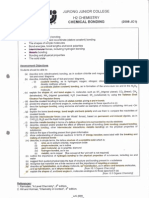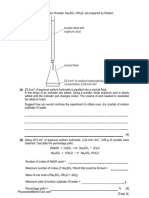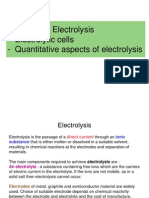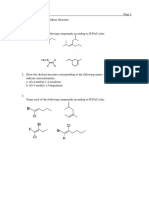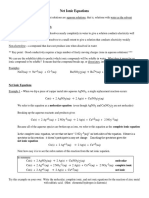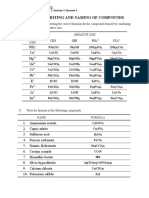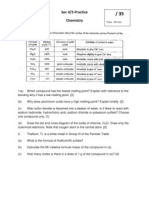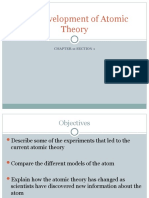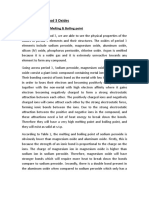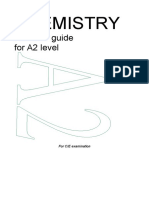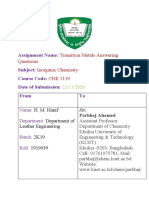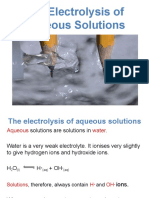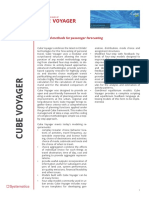Transition Elements
Transition Elements
Introduction
Definition
-
Transition element: d-block element that forms at least 1 ion with a partiallyfilled d-subshell
i.e. Scandium (Sc3+: [Ar] 3d04s0) and Zinc (Zn2+: [Ar] 3d10 4s0) are technically not
counted as transition metals
Sc: [Ar] 3d14s2 Sc3+: [Ar] 3d04s0
Zn: [Ar] 3d104s0 Zn2+: [Ar] 3d104s0
Scandium only forms Sc3+ which has a 3d0 configuration in all its compounds
Zinc only forms Sc2+ which has a 3d10 configuration in all its compounds
Electronic Configuration of Transition Elements
First row transition elements have similar electronic configuration of [Ar] 3d x4sy
where [Ar]=1s22s22p63s23p6 and 1x10 and y=2. Chroium and copper is an
exception where y=1
In period 4, an empty 4s orbital has a lower energy than an empty 3d orbital.
Thus the 4s orbital is filled first before the 3d orbital, according to aufbau
principle
Element No. of e-
Electronic
Configuration
Ca
20
[Ar]4s2
Sc
21
[Ar]3d14s2
Ti
22
[Ar] 3d24s2
23
[Ar] 3d34s2
Cr
24
[Ar] 3d54s1
Mn
25
[Ar] 3d54s2
Fe
26
[Ar] 3d64s2
Co
27
[Ar] 3d74s2
Ni
28
[Ar] 3d84s2
Cu
29
[Ar] 3d104s1
Zn
30
[Ar] 3d104s2
Maximum Oxidation
State
Representation
[Ar]
[Ar]
[Ar]
[Ar]
[Ar]
[Ar]
[Ar]
[Ar]
[Ar]
[Ar]
[Ar]
+2
+3
+4
+5
+6
+7
+6
+5
+4
+3
+2
Maximum oxidation state given by the number of unpaired 3d electrons + 4s
electrons
Anomalous Electronic Configurations
-
Cr and 29Cu have only 1 4s electrons because it a half-filled 3d 5 or completely
filled 3d10 orbitals are favourable arrangements of electrons respectively
24
3d
4s
�Transition Elements
Cr: 3d and 4s orbitals are very close in energies. Occupancy of orbitals is
determined by inter-electron repulsions rather than energy differences between
orbitals
Formation of Cations
-
Empty 3d orbitals are of higher energy level than empty 4s orbitals 4s
orbitals are filled up first
Filled 3d orbitals are of lower energy level than filled 4s orbitals 4s
orbitals are lost first
Filled 4s orbitals behave as outermost, highest-energy orbital and 4s electrons
become the valence electrons in cations, valence 4s electrons are lost first,
followed by 3d electrons
Fe:
Fe2+:
Fe3+:
�Transition Elements
- Physical Properties
-
Effective nuclear charge
-
is relatively invariant across transition elements
trend
explan
ation
Across period 4 main group
elements
Increases significantly
Nuclear charge increases
due to increasing number of
protons. Nuclear charge
increases
Electrons are added to
same outermost shell.
Nuclear charge increases
but shielding effect from
inner electrons remain
relatively constant
Increase in nuclear charge
outweighs negligible
increase in shielding effect
from inner electrons
Effective nuclear charge
increases significantly
Across first row transition
elements
Relatively Invariant
Nuclear charge increases
due to increasing number of
protons.
Electrons are added to
penultimate 3d orbitals.
Nuclear charge increases
Increase in shielding effect
from 3d electrons almost
cancels out increase in
nuclear charge
Effective nuclear charge
remains relatively invariant
Atomic radii
Trend: atomic radii are relatively invariant across transition elements
�Transition Elements
trend
explan
ation
Across period 4 main group
elements
Decreases significantly
Nuclear charge increases
due to increasing number of
protons. Nuclear charge
increases
Electrons are added to
same outermost shell.
Nuclear charge increases
but shielding effect from
inner electrons remain
relatively constant
Increase in nuclear charge
outweighs negligible
increase in shielding effect
from inner electrons
Effective nuclear charge
increases significantly
Atomic radius decreases
significantly
Across first row transition
elements
Relatively Invariant
Nuclear charge increases
due to increasing number of
protons.
Electrons are added to
penultimate 3d orbitals.
Nuclear charge increases
Increase in shielding effect
from 3d electrons almost
cancels out increase in
nuclear charge
Effective nuclear charge
remains relatively invariant
Atomic radius remains
relatively invariant
s-block elements
-
Transition metals has smaller atomic radii than s-block metals from same
period
Across Period 4, NC increases due to increase in number of protons.
Within transition metals, Each additional electron enters penultimate 3d
shell.
Although 3d electrons shield outer 4s electrons from nuclear charge, 3d
electrons provide a poor shield between outermost 4s electrons and the
nucleus
Valence electrons are still strongly attracted by the nucleus
Increase in effective nuclear charge across Period 4 results in smaller atomic
radii for transition metals
Ionic radii
Ionic radii are relatively invariant across transition elements
�Transition Elements
Ionic radius is not a fixed property of any given metal ion but varies with
many other parameters like magnitude of positive charge, coordination
number, spin state etc.
General trends
Ionic radius decrease as magnitude of positive charge increase
Ionic radius increases as magnitude of negative charge increase
Among cations with the same positive charge, ionic radii remain relatively
invariant across transition elemetns
s-block elements
-
TM has smaller atomic radii than s-block metals of same period
Increase in ENC across Period 4 draws electrons closer to the nucleus
Results in smaller ionic radii for transition metal ions as compared to s-block
metal ions of the same charge
First ionisation energy
-
First ionisation energies remain relatively invariant across transition elements
Across period 4 main group
Across first row transition
�Transition Elements
elements
trend
- Increases significantly
explan - 1st IE involves the removal of
ation
outermost 4s or 4p electrons
- Nuclear charge increases
due to increasing number of
protons. Nuclear charge
increases
- Electrons are added to same
outermost shell.
- Nuclear charge increases
but shielding effect from
inner electrons remain
relatively constant
- Increase in nuclear charge
outweighs negligible
increase in shielding effect
from inner electrons
- Effective nuclear charge
increases significantly
- Energy needed to remove
outermost electron increases
significantly
elements
- Relatively Invariant
-1st IE involves removal of
outermost 4s electrons
- Nuclear charge increases
due to increasing number of
protons.
- Electrons are added to
penultimate 3d orbitals.
- Nuclear charge increases
Increase in shielding effect
from 3d electrons almost
cancels out increase in
nuclear charge
- Effective nuclear charge
remains relatively invariant
- Energy needed to remove
outermost electron remains
relatively invariant
Anomaly: zinc
Zn has a significantly higher first IE than other d-block elements.
-
Cu: [Ar] 3d10 4s1 1st IE = 745 kJ mol-1
Zn: [Ar] 3d10 4s2 1st IE = 906 kJ mol-1
- 1st IE involves removal of a 4s electron
- Zn has 1 more proton than Cu, hence has a stronger nuclear charge
- From Cu to Zn, the electron is added to the valence 4s orbital, which experiences
the same shielding from inner electrons. Theyhave the same number of inner
shell electrons, hence same shielding effect
-
ENC then increases 4s electron is held more closely to the nucleus, hence
more energy is needed to remove a valence electron from Zn
S-block elemnts
-
Transition elemnets have higher first ionisation energies than s-block metals
of the same period
Across TE,
Across Period 4, NC increases due to increase in number of protons.
Within transition metals, Each additional electron enters penultimate 3d
shell.
�Transition Elements
Although 3d electrons shield outer 4s electrons from nuclear charge, 3d
electrons provide a poor shield between outermost 4s electrons and the
nucleus
Valence electrons are still strongly attracted by the nucleus
Increase in effective nuclear charge across Period 4. More energy is
needed to remove a valence electron from a transition metal atom than from
an s-block metal atom
1st and 2nd are relatively invariant
3rd and 4th generaly increase
- 2nd, 3rd and 4th IE shows a peak at Cr+, Mn2+ and Fe3+ respectively
o All 3 ions share the same configuration of [Ar] 3d 5, where the d electrons are
unpaired and are in singly orbitals
-
Subsequent d-electrons have to share an orbital occupied by an electron
interelectronic repulsion exists in the d electron being removed from Mn +, Fe2+
and Co3+ (adjacent to Cr+, Mn2+ and Fe3+)
Density
Trend: across transition metals, density generally increases.
�Transition Elements
- Across transition elements, atomic mass increases
- Atomic radius remains relatively invariant density generally increases
-
Other factors include the crystal structures
s-block elements
transition elements are much denser than s-block elements
s-block elements
- Low
Transition elements
- Very high
Tre
nd
Re
aso
n
Melting and boiling points
Trend: transition elements have higher m.p. and b.p. than s-block elementsss
Smaller atomic mass
Large atomic radius
Fewer atoms per unit volume
Higher atomic mass
Small atomic radius
Closely packed metallic
structure results in more
atoms per unit volume
Tre
nd
Re
aso
n
s-block elements
- Generally Lower
-
only 1 or 2 valence electrons
from 4s orbitals are available
for delocalisation
less enrgy is required to
overcome weaker metallic
bonding i.e. electrostatic
forces of attraction between
the metal cations and sea of
delocalised 4s valence
Transition elements
- generally higher
-
both 3d and 4s valence
electrons are available for
delocalisation due to their
proximity in energies
more energy is required to
overcome stronger metallic
bonding i.e. electrostatic
forces of attraction between
the metal cation and sea of
�Transition Elements
electrons
delocalised 3d and 4s
valence electrons
Mechanical properties
Higher tensile strength can withstand stress while being stretched/pulled
before becoming warped
More malleable readily beaten into shape
More ductile can be drawn into a wire
-
Due to stronger metallic bonding
Layers of closely packed atoms slide over each other without disrupting
stronger electrostatic attraction between cations and delocalised electrons
Electrical and thermal conductivity
Lower conductivities than s-block elements in the same period, except Cu
-
Calcium
- Copper
- Very good conductor
- Both 4s and inner 3d electrons are
- Good conductor
- Inner shell electrons are not available for
available for delocalisation due to
delocalisation as they are very different
their proximity in energies
Note:
not all 3d electrons are
in energies from the valence electrons
- Fewer electrons are available to conduct
delocalised and used in conduction
- More electrons are available to
current/heat
conduct a current/heat
- Chemical properties
-
Trends in Oxidation States
-
TM possess variable oxidation states whie s-block elements are limited to
oxidation states of +1 (Group I) or +2 (group II)
Elem
ent
Electronic
Configuration
Oxidation State
�Transition Elements
Ca
Sc
Ti
[Ar]4s2
[Ar]3d14s2
[Ar] 3d24s2
[Ar] 3d34s2
Cr
[Ar] 3d54s1
Mn
[Ar] 3d54s2
Fe
[Ar] 3d64s2
Co
[Ar] 3d74s2
Ni
Cu
Zn
[Ar] 3d84s2
[Ar] 3d104s1
[Ar] 3d104s2
- +2
- +3
+1, +2, +3, +4
+1, +2, +3, +4,
+5
+1, +2, +3, +4,
+5, +6
+1, +2, +3, +4,
+5, +6, +7
+1, +2, +3, +4,
+5, +6
+1, +2, +3, +4,
+5
+1, +2, +3, +4
- +1, +2, +3
- +2
In transition elements:
4s and 3d electrons are of similar energy
when 4s electrons are removed, some or all of 3d electrons may also be
removed or shared without requiring much more energy
In s-block elements:
When the outermost electrons in s orbitals are removed, a stable noble gas
configuration is obtained
Subsequent removal of electrons would be from inner shell p orbitals which
requires too much energy
Further ionisation is then not favourable
Max O.S. = no. of 4s electrons + no. of unpaired 3d electrons
No. of available O.S. increases from Sc (+3 only) to Mn (+7, from +1 to +7) and
decreases to Zn ( +2 only)
Mn has the most number of oxidation states
After Mn (3d5) Pairing of 3d electrons occurs and no. of unpaired 3d electrons
available for covalent bond formation decreases
All first row d-block elements show an oxidation state of +2 which corresponds to
the loss of two 4s electrons
except Sc, [Ar]3d14s2 since it is more favourable to lose all 3 electrons to
form a stable noble gas configuration of [Ar]
All first row d-block elements show an oxidation state of +3 which corresponds to
the loss of one 3d and two 4s electrons
- except Zn, [Ar] 3d104s2 since it is more difficult to remove 3d electrons from
3d orbitals as 3d orbitals become significantly lowr in energy than 4s orbitals
as nuclear charge increases
At lower O.S., transition elements exist as cations in ionic compounds
E.g. Cu2+ in CuSO4, Mn2+ in MnCl2, Fe3+ in Fe2(NO3)3
At higher O.S., transition elements form covalent compounds or oxoanions 1
1 Refers to chemical compounds with the generic formula A xOyz-
�Transition Elements
At high O.S., the cations are highly polarising due to high charge density can
only exist as covalent compounds (e.g. TiCl 4, V2O5) or oxoanions (e.g. CrO42-,
Cr2O72-, MnO4-)
- Generally TM ions of charges +4 and above cannot exist in aqueous solutions
- E.g. Vanadium exists in aqueous solutions as V 2+ or [V(H2O)6]2+ ion. Once it is
oxidised to the +4 or +5 oxidation state, it exists as VO 2+ or VO2+ in water
respectively
- The Cr3+ ions can be found in aqueous solution but once this ion is oxidised to
Cr(VI), it exists as either CrO42- or Cr2O72- ion in water
- Nature of
- O.S.
- Example
Oxide
- Low
- Ionic
- MnO (+2) + H2SO4 MnSO4 + H2O
- +2, +3
- Basic
- Intermediat
- Cr2O3 (+3) + 2NaOH + 3H2O 2NaCr(OH)4
e
- Amphoteric
- Cr2O3 + 3H2SO4 Cr2(SO4)3 + 3H2O
- +4
- High
- Covalent
- Mn2O7 (+7)+ 2NaOH 2NaMnO4 + H2O
- +5, +6, +7
- Acidic
-
Relative Stabilities of oxidation states of transition elemnets in
therms of E
-
Relative Stabilities of oxidation states of transition elemnets are reflected by
standard electrode potential E
The more positive the E value, the more likely the forward reaction i.e.
reduction will occur
Trend: Relative stability of +2 O.S. w.r.t. +3 O.S. increases across the transition
element series (except Fe and Cr)
-
shown by E of M3+ (aq) + e M2+, more positive higher tendency to
reduce to M2+
-
note:
�Transition Elements
i.
Accurate data for the chart is necessarily incomplete since Sc2+, Cu3+ and
Zn3+ do not exist and Ni3+ is not stable in aqueous solution
ii. E data for Sc, Cu and Zn included in the chart have been estimated from
ionisation energy and hydration energy data
Anomaly: The E value for Fe3+(aq)/Fe2+(aq) is more negative than the E value
for Mn3+(aq)/Mn2+(aq)
Oxidation of M2+ to M3+ involves the removal of 3rd electron from 3d orbital
Trend is broadly similar to that of third ionisation energies M2+ (g) M3+(g),
including dip from Mn to Fe
Removal of 3rd electron from d6 system of Fe2+ is easier due to interelectronic
repulsion between 3 electrons occupying the same d-orbital
Fe2+ is a stronger reducing agent than expected (prefers to be oxidised, i.e. exist
as Fe3+)
Anomaly: The E value for Cr3+(aq)/Cr2+(aq) is more negative than
the E value for V3+(aq)/V2+(aq)
- Break in trend is not reflected in the general trend for third
Cr2+
ionisation energies
Under presence of H2O ligands, d orbitals are split into 2 groups of different
energy
Removal of 3rd electron from d4 system of Cr2+ is easier since the electron
removed is from a higher energy group
Cr2+ is thus a stronger reducing agent than expected
Oxidation Abilities
Compounds of TM with high O.S. tend to have oxidising properties
indicated by presence of high +ve E values
Reducing Abilities
TM in elemental states generally have reducing properties, reducing ability
decreases across the row
Low/negative E values of M2+ (aq)/M (s) systems
E generally becomes less negative/more positive
reduction from M2+ to M becomes more likely
reduction from M to M2+ becomes less likely from element to elemnet
Cr3+
�Transition Elements
thus reducing acility of transition metal generally decreases
- Complexes
-
Complex Formation
Complex formed when a metal ion or atom forms dative covalent or
coordinate bonds with surrounding ions or molecules called ligands
Ligand Neutral or anions which possess at least 1 unshared pair of
electrons used to form a coordinate bond with the central metal atom/ion
Reason:
Transition metal cations have
I.
Vacant low-lying orbitals (e.g. 3d, 4s, 4p orbitals)
ii.
high charge density able to attract molecules or anions (ligands)
that are rich in electrons.
- Able to attract molecules or anions (ligands) that are rich in electrons to
form dative bonds in its vacant orbitals
Metal cation acts as lone pair acceptor (lewis acid) and ligands as lone pair
donors (lewis base)
- Lone pair from each ligand occupies energetically accessible vacant orbital on
the central transition ion to form a dative covalent/coordinate bond
Features of a complex
1. Net Charge on Complex
- Sum of oxidation state or charge on metal ion and the charge on the ligands
- Net Charge = O.S. of Metal Ion + Charge on Ligands (either neutral or
negative)
- E.g. [CuCl4]2-, [Cu(NH3)4(H2O)2]2+
2. Coordination Number
- Defined as no. of dative bonds formed between ligands and the central metal
atom or ion
- Cu2+ ions coordination no. of 6 with H2O, but 4 with Cl- Different metal ions may show different coordination number with the same
ligand
Types of Ligands
Classified based on number of atoms
May be neutral or negatively charged ions
May be some atoms with lone pairs in the ligand that do not donate to the
central metal atom or ion e.g. ethanedioate ion
-
Monodentate
Bidentate
2 atoms in each ligand binds to
metal
3 atoms in each ligand binds to
metal
:Cl-, :OH-, -:CN, H2O:,
:NH3, :CO
1 atom in the ligand binds to
metal
H2N:CH2CH2:NH2
- C2O42-
Tridentate
-
DETA:
-
�Transition Elements
Hexadentate
6 atoms in each ligand bind to
metal
EDTA
-
Monodentate
Only one atom in a monodentate ligand binds to the metal
No. of coordinate bonds formed between metal and each ligand=1
Common monodentate ligands
-
Ligand
Type
Name
Bidentate
Only one atom in a monodentate ligand binds to the metal
No. of coordinate bonds formed between metal and each ligand=2
Common bidentate ligands
-
Ligand
Type
Name
structure
Nature of complexes
Complexes can be neutral, cationic or anionic
Net chage on complex = (O.S. or charge on metal ion) + (total charge on
ligands)
Net charge>0 cationic
Net charge=0 neutral
Net charge<0 anionic
Shapes of Complex Ions
1. Coordination No. = 2: Linear
2. Coordination No. = 4: Tetrahedral or Square
Planar
3. Coordination No. = 6: Octahedral
- Coordinati - Coordinati - examples on
on
shape
�Transition Elements
number
2
geometry
Linear
Tetrahedr
al
Square
planar
Octahedra
l
Complex Chemistry
Colour of Complexes
Transition metal complexes are usually coloured both in the solid state and in
solution
-
C o
H 2O
Pink
Soln
OH-
Blue/green Ppt
[Co(H2O)4(OH)2]
NH3 (2)
- YellowishBrown Soln
-
CO32-
Pink
Ppt
Others
-
�Transition Elements
[Co(
H2O)6
]2+
C r
3
Violet
Soln
[Cr(H2
O)6]3+
Green
ppt
[Cr(H2O)
3(OH)3]
L.
Gree
n
Soln
[Cr(
OH)6
]3-
L.
Blue
Soln
- [Cu(
H2O)6
]2+
C
u
2
+
[Co(NH3)6]2
L. Blue Ppt
[Cu(H2O)4{OH)2]
CoCO3
Green Soln
[Cr(NH3)6]3+
Dark Blue
Soln
[Cu(NH3)4
(H2O)2]2+
[Cu(NH3)4
]2+
Blue/gr
een Ppt
CuCO3
Yellow
[CuCl4]2-
F
e
3
+
Pale
Yellow
Soln
[Fe(H2
O)6]3+
Brown Ppt
Brown
Ppt
Efferve
scence
[Fe(H2O
)3(OH)3]
[Fe(H2O)3(OH)3]
Deep
/Blood
Red
[Fe(H2O)5
(SCN)]2+
- Red
[Fe(CN)6]
3+
Pale
Green
Soln
2
- [Fe(H2
+
O)6]3+
- Pink
M
Soln
n - [Mn(
2
H+
2
O)
2
6]
F
e
N
i
2
+
Blue
Soln
- [Ni(N
H3)6]2+
Dark Green Ppt
[Fe(H2O)4(OH)2]
Dark
Green
Ppt
FeCO3
Yellow
[Fe(CN)6]4-
Blue Soln
[Ni(NH3)6]2
+
2 Under dilute NH3 (aq) conditions, ligands will be OH. Under concentration NH3
conditions, ligands will be NH3
�Transition Elements
Explanation of Colour of Complex
Isolated transition metal ions has 5 degenerate 3d orbitals, all
with same energy
When transition metal ions are surrounded by ligands, d-orbitals
are split into 2 groups of different energy levels3
When white light shines onto the complex, an electron in the d orbital of lower
energy level is promoted to an empty or partially-filled d orbital of higher
energy, undergoing d-d electronic transition
During the transition, the d electron absorbs a quantum of light of certain
wavelength from the visible region of the electromagnetic spectrum
The colour observed is then the colour of transmitted light, which is a
mixture of remaining wavelengths that have not been absorbed
Complementary Colours
Y
G
If a colourBis absorbed, the main colour of the transmitted light is the other colour
R
V
e.g. Explanation of Colour of Cu2+ (aq) Blue
In aqueous solutions, each Cu2+ ion is surrounded by 6 H2O ligand in an octahedral
complex, [Cu(H2O)6]2+
H2O ligands split the d orbitals of Cu2+ (aq) ions into 2 groups of energy levels
Cu2+ (aq) ions undergo the following energy transition when they absorb light:
The ions will absorb visible light of a certain energy level corresponding to the energy
gap, i.e. red light
Colour observed is the colour of transmitted light, blue, which is the complement of the
colour absorbed
Factors Affecting Colours
Depends on the energy gap E between the two groups of d-orbitals. It depends
on
i. Identity of metal and its O.S.
ii. Shape of complex ion
iii. Nature of ligands
3 Electrons in d-orbitals and those in ligand repel each other, hence d-orbitals closer
to ligands will have a higher energy than those further away which results in dorbitals splitting in energy
�Transition Elements
Absence of colour in Sc(III), Zn(II) and Cu(I) compounds is due to either
no d electrons or a completely filled d subshell, hence dd
transition is not possible
Higher the O.S., the larger the d-d orbital splitting larger E
- Nature and
shorter
O.S. of Metal
o Fe2+ (aq) Green (red absorbed), Fe3+ (aq) Yellow (violet
absorbed)
o Cr2+ (aq) Blue (orange absorbed), Cr 3+ (aq) Violet (yellow
absorbed)
To absorb light, a metal ion must possess at least 1 d electron and
an empty or partially filled d-orbital in higher energy level
o Sc3+ compounds are not coloured [Ar]3d04s0 no d-electron
- No. of d
for dd transition
Electron
o Cu+/Zn2+ compounds are not coloured [Ar]3d104s0 all d
orbitals are completely filled with electrons no dd
transition
Splitting pattern of d orbitals depend on shape of complex ion,
which results in different energy gaps between high and low energy
groups
- Shape of Different wavelength of avsorbed light
Complex Ion
Nature of
Ligand Ion
Different ligands split the d orbitals to a different extent different
energy gaps between high and low energy groups amount of
energy absorbed by d electron during dd transition differs
A stronger field ligand causes a larger split in d orbitals larger
energy gap lower absorbed light of longer transmitted
- Strength of Ligands:
(large ) I < Br < SCN- < Cl- < F- < -OH < C2O42- H2O < NCS- < NH3
< NO2- < CN- CO (small )
2+
[Fe(H2O)6] - pale green (red absorbed)
[Fe(CN)6]4- - yellow
(violet absorbed)
-
Ligand Exchange
Stronger ligand can displace a weaker ligand from a complex ion during ligand
exchange
Weaker ligands can also displace a stronger ligand if the weaker ligand is of high
concentrations
If ML6 + Y ML5Y + L Y is a stronger ligand than L, replacing L in ML 6 to form
a more stable complex
E.g.
Conc HCl when added to Cu2+ (aq), solution changes from blue to green
�Transition Elements
Cl- ions in high concentrations displaces H2O ligands in the blue [Cu(H2O)6]2+ complex
to form yellow [CuCl4]2- complex: [Cu(H2O)6]2+ (aq) + 4Cl- (aq) [CuCl4]2- (aq) + 6H2O
(l)
Presence of both blue [Cu(H2O)6]2+ and yellow [CuCl4]2- complex ions give the
solution a green colour
Ligand exchange for oxyhaemoglobin, carbaminohaemoglobin and
carboxyhaemoglobin
CO2 ligand can be displaced by O2 to form oxy-haemoglobin in a reversible reaction,
allowing haemoglobin to carrying oxygen from one part of the body to another
CO2/O2 ligand can also be replaced irreversibly by a stronger CO ligand, which
prevents O2 molecule from binding to the Fe2+ ion in haemoglobin to form
oxyhaemoglobin toxic CO and CNAnhydrous CuSO4 (white) dissolves readily. Describe and explain observations when
anhydrous CuSO4 is stirred with water, followed by addition of NH3 (aq) until in
excess
- Pale blue solution is formed Formation of [Cu(H2O)6]2+ complex ions
- CuSO4 (s) + 6H2O [Cu(H2O)6]2+ (aq) + SO42- (aq)
- Pale blue precipitate forms when NH3 is added Formation of [Cu(H2O)4(OH)2](s)
- (1): [Cu(H2O)6]2+ (aq) + 2OH- [Cu(H2O)4(OH)2] + 2H2O, where OH- replaces H2O
as ligands
- Deep blue solution is in excess NH3 formation of [Cu(NH3)4(H2O)2]2+
- (2): [Cu(H2O)6]2+ (aq) + 4NH3 [Cu(NH3)4(H2O)2]2+ + 4H2O, where stronger NH3
ligands replaces weaker H2O ligands to form a deep blue complex
- Decreases concentration of [Cu(H2O)6]2+ in solution. By LCP, equilibrium (1) shifts
left to increase concentrations of [Cu(H2O)6]2+ (aq) precipitate dissolves
